Sunday, May 20, 2007
First Day of our Study
NOAA Teacher At Sea: Jacob Tanenbaum 
NOAA Ship MILLER FREEMAN
Mission: Fisheries Oceanography Coordinated Investigations
Sea Wave Height: 5
Water Temperature: 6.5 Degrees C.
Wind Speed: 12 Kts.
Air Temperature: Pressure: 8.4 Degrees C.
Personal Log:
This morning we were treated to a spectacular Alaska dawn. This time of year up here, the sun takes a long time to come up, so dawn begins early and the light stays beautiful for ages. Here are some photos. There are more in the gallery section of the website as well.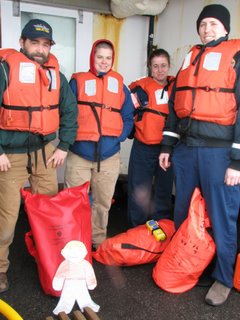
Today we also had more drills to practice what to do in case of an emergency. On a ship, in addition to having fire drills, we also have “abandon ship” drills. Here, members of the crew, including “Flat Stanley,” our visitor from Virginia, all “muster” with their flotation and survival gear next to our life raft station.
Science Log:
The scientists worked all night collecting plankton samples. One of the main interests is collecting the larvae, or baby Pollock. Remember the fish we studied here last summer? Well this year, we are studying baby Pollock. Baby Pollock, or Pollock larvae are considered part of the plankton community because they are not strong enough to swim against the current. The samples we take here are very different from the ones that we took last summer. Here are some samples side by side. Last year we had to lift our samples on to the ship with a crane. Today, our samples come in small bottles and petri dishes. What a difference!
This is what Pollock look like as adults:
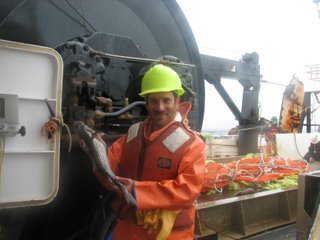
This is what they look like as larvae (babies)
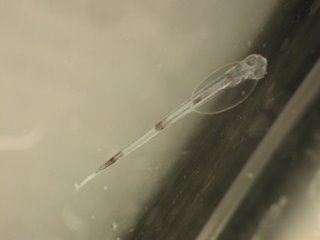
Here is a sample of adult pollock from last year
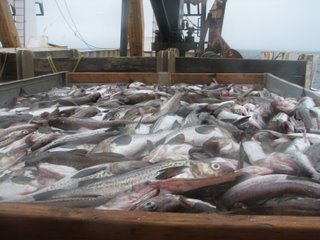
Here is a sample from this year
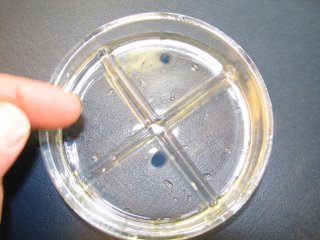
Here is how we measure adults
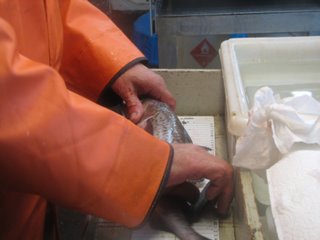
Personal Log:
This morning we were treated to a spectacular Alaska dawn. This time of year up here, the sun takes a long time to come up, so dawn begins early and the light stays beautiful for ages. Here are some photos. There are more in the gallery section of the website as well.
Today we also had more drills to practice what to do in case of an emergency. On a ship, in addition to having fire drills, we also have “abandon ship” drills. Here, members of the crew, including “Flat Stanley,” our visitor from Virginia, all “muster” with their flotation and survival gear next to our life raft station.
Science Log:
The scientists worked all night collecting plankton samples. One of the main interests is collecting the larvae, or baby Pollock. Remember the fish we studied here last summer? Well this year, we are studying baby Pollock. Baby Pollock, or Pollock larvae are considered part of the plankton community because they are not strong enough to swim against the current. The samples we take here are very different from the ones that we took last summer. Here are some samples side by side. Last year we had to lift our samples on to the ship with a crane. Today, our samples come in small bottles and petri dishes. What a difference!
This is what Pollock look like as adults:
This is what they look like as larvae (babies)
Here is a sample of adult pollock from last year
Here is a sample from this year
Here is how we measure adults
To measure larvae, we use a microscope to photograph the larvae and then measure their image on the picture using special computer software.

Here is a photo of us bringing up the nets, called bongos, full of plankton.
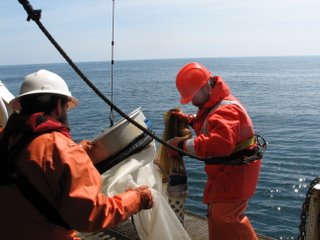
Question of the day:
Why do you think it is important to study babies? Students on Monday, please look at yesterday's log and answer those questions too!
Here is a photo of us bringing up the nets, called bongos, full of plankton.
Question of the day:
Why do you think it is important to study babies? Students on Monday, please look at yesterday's log and answer those questions too!
Do you have questions for the scientists? Write them down! They would love to hear from you.
Photos
Sunrise in Alaska
Crewmembers of NOAA Ship MILLER FREEMAN muster for an abandon ship drill
Adult Pollock and NOAA Teacher At Sea Jacob Tanenbaum in June of 2006 on NOAA Ship MILLER FREEMAN
Pollock larvae under the microscope
Haul of Adult Pollock from June of 2006
Pollock larvae in a petri dish
Measuring adult Pollock in June of 2006
NOAA Teacher At Sea Jacob Tanenbaum at the microscope on NOAA Ship MILLER FREEMAN
Chief Survey Technician Philip White and NOAA Teacher At Sea Jacob Tanenbaum bringing in bongo nets on NOAA Ship MILLER FREEMAN
Photos
Sunrise in Alaska
Crewmembers of NOAA Ship MILLER FREEMAN muster for an abandon ship drill
Adult Pollock and NOAA Teacher At Sea Jacob Tanenbaum in June of 2006 on NOAA Ship MILLER FREEMAN
Pollock larvae under the microscope
Haul of Adult Pollock from June of 2006
Pollock larvae in a petri dish
Measuring adult Pollock in June of 2006
NOAA Teacher At Sea Jacob Tanenbaum at the microscope on NOAA Ship MILLER FREEMAN
Chief Survey Technician Philip White and NOAA Teacher At Sea Jacob Tanenbaum bringing in bongo nets on NOAA Ship MILLER FREEMAN
Comments:
<< Home
how is life at cold places such as alaska, a really cold state thats really cold so you should dress in layers. Dont eat sushi
how are you doing are you only eating fish did you see any polar bears. remember dont drink to much salt water bye bye for now
Hi! How are you? Are you dicovering new things? Things you didn't know or discover last year?
Well, not much is going on here.
Have fun! Bye!
Ceara
Well, not much is going on here.
Have fun! Bye!
Ceara
Hey Mr. Teacher at Sea
Great blog again. The pictures are stunning, especially with the boat moving against the snowy mountains, and sunrise. Keep up the great work
Your brother on land
Post a Comment
Great blog again. The pictures are stunning, especially with the boat moving against the snowy mountains, and sunrise. Keep up the great work
Your brother on land
<< Home









